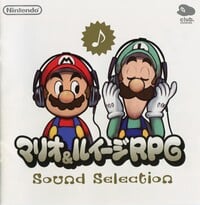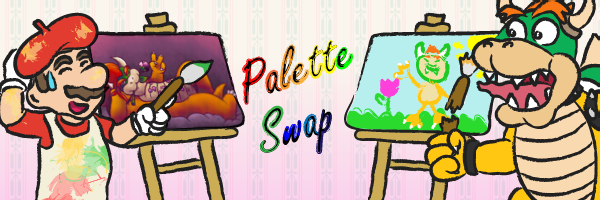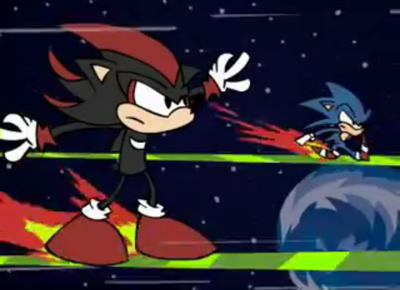The 'Shroom:Issue 104/Palette Swap
Director's Notes
Hello, all, welcome to our sleepy November issue!
For this month, I would definitely advise you to check out Crocodile Dippy (talk)'s section this month, as she's put a TON of work in it. It's a lovely section, you simply MUST read it!
Next issue, we'll be starting a Holiday Art Contest, so keep you eyes on this space for more details!
Section of the Month
No surprise, Walkazo (talk) takes home the trophy again for Section of the Month! Congratulations, Walkazo, you'll have an entire year of awards soon!
| Palette Swap SECTION OF THE MONTH | ||||
|---|---|---|---|---|
| Place | Section | Votes | % | Writer |
| 1st | The Adventures of Little Mario | 7 | 58.33% | Walkazo (talk) |
| 2nd | Composer Spotlight | 2 | 16.67% | Crocodile Dippy (talk) |
| 2nd | What’s On The Box? | 2 | 16.67% | Yoshi876 (talk) |
| 4th | Ongoing Fan Projects | 1 | 8.33% | Yoshi876 (talk) |
Sprite of the Month
Greetings, readers! By now, you’ve probably heard about the Nintendo Direct that aired on the 12th of this month. Unless you’ve been living under a rock, I guess, but getting back to the point, lots of new information was presented about new and current games, including Mario & Luigi: Paper Jam. So, for this issue, I’ll be revisiting some of the sprites of our portly plumber protagonists from the first games of the two series in this crossover.
First up, I’ve got some jumping poses from Mario & Luigi: Superstar Saga ![]()
![]()
![]() The only game I’ve played out of the series is Bowser's Inside Story but I do remember that the jumping and movement mechanics of the game were fantastic. So fluid and easy to control!
The only game I’ve played out of the series is Bowser's Inside Story but I do remember that the jumping and movement mechanics of the game were fantastic. So fluid and easy to control!
Next is the original Paper Mario from the N64. ![]()
![]() Wow, he sure looks different, doesn’t he? 16 years can really do that to you. Actually, looking at the current art style, he looks younger now than he does in these sprites. That’s certainly odd. Maybe he picked up a youth potion on the way back from Creepy Steeple?
Wow, he sure looks different, doesn’t he? 16 years can really do that to you. Actually, looking at the current art style, he looks younger now than he does in these sprites. That’s certainly odd. Maybe he picked up a youth potion on the way back from Creepy Steeple?
Ongoing Fan Projects
| User | Thread | Description |
|---|---|---|
| Niiue | Niiue's Sprites | A thread that showcases sprites that Niiue has created. Recent updates to the thread include a guitar and a diamond. |
| Smg2daisy | A Pokémon a Day Showthread! | A thread where Smg2daisy draws Pokémon. Although the thread title says every day, it is not updated as such, in the past month the only update was a very good drawing of a Wingull. |
| Smg2daisy | Smgsdaisy Decides To Make Requests With Themes | A thread where Smg2daisy draws images to a certain theme. Meta Knight was recently drawn, but the theme has now changed to album covers. |
| PrincessPeach1989 | My Stuff | A thread where PrincessPeach1989 shows off some recolours she's done. The current recolours are of the Monado, the Super Star, Ice Mario (from Super Mario Galaxy), a Luma and Princess Peach. You should really check this thread out. |
| Porygon-Z | PIK's Fanmade Pokémon Cards | A thread where Porygon-Z shows off some custom-made Pokémon cards he's made. The three cards are Mario, Luigi and Princess Peach. |
8-Bit Amphitheater
Written by: Stooben Rooben (talk)
Hello, dear listeners! Welcome to another edition of 8-Bit Amphitheater. I promise I won't pistol-whip you with forced puns. I know that kind of behavior can be a real thorn in some people's sides. So, with that, on to this month's content!
| This Month's Chiptunes | ||||||
|---|---|---|---|---|---|---|
| Song Title and Contributing Artists | Genre | Album Name and Year of Release | Original Song | |||
| "November Rain", by Guns N' Roses | YT | SC | DL | Symphonic rock | Use Your Illusion I — 1991 | Original |
Oh no, it's only one song! That's okay though, because it's nearly as long as three individual ones anyway. This month's mainstream chiptune is the epic Guns N' Roses staple, "November Rain". I really hope I don't have to explain why I picked that song this month. While there are a lot of autumn-, November-, or chilly-themed songs I'd love to have done this month, I simply didn't have time. As a result, I resorted to a song I believe a lot of people know or would at least recognize. "November Rain" is somewhat of a power ballad, featuring a lengthy piano introduction with orchestral accompaniment that lasts throughout the whole song. Also featured in the song are three lengthy guitar solos by a guy that looks like this, the last of which is the highlight of a very foreboding coda. It's really quite an impressive tune, and I think it's very accessible considering its length (almost nine minutes). If you've never heard it before, definitely check it out! If you have, then you probably know how it goes already. Either way, I hope you enjoy the chiptune.
| This Month's Chiptunes | ||||||
|---|---|---|---|---|---|---|
| Song Title and Contributing Artists | Genre | Album Name and Year of Release | Original Song | |||
| "Click Clock Wood (Fall)", by Grant Kirkwood | YT | SC | DL | Orchestral pop | Banjo-Kazooie OST — 1998 | Original |
Oh no, it's only one song! Again! That's okay though, because it's a freakin' Banjo-Kazooie track. Right? Right. Though I have regrettably never had the chance to play any games in the series, I am pretty familiar with its soundtrack. I find everything about it catchy and well-constructed; the dynamic aspect of the music, how it evolves as you explore the game world, is something I find really fascinating and imagine adds layers to the whole experience when playing. I chose this particular track because of its blustery nature, which fits in perfect with its fall title and theme. The original song has a bunch of cool animal noises that make the track really come alive (frogs croaking, woodpeckers pecking, songbirds whistling), but unfortunately I found the task of capturing those sounds impossible. The chiptune, as a result, sounds slightly more stripped than some others I've done, but I think it still keeps true to the spirit of the song and its respective game.
That's all for this month! Next month, we'll be seeing a much larger shipment of chiptunes roll in, so stay tuned! Or chiptuned, as the case may be.
Oh dear, there I go with those irredeemable jokes again.
Mario's Boombox
And now for something completely different... Mario's Boombox's is featuring a song that has absolutely nothing to do with video games, but when you hear the lyrics, you can sorta picture how it could fit in:
I could go Super Sonic
the problem's chronic
Tell me does life exist beyond it
When I need to sate
I just accelerate
Into oblivion
And someone going by the handle of BigArmyBug indeed thought just that, and made and uploaded the video pictured on the right to Newgrounds many years ago (and a fan subsequently uploaded it to YouTube). Contrary to the name, it is not about Sonic the Hedgehog changing into his Super Sonic form, but about Shadow taking his Super form and getting into scraps and whatnot. But it makes sense that it's about the edgier Shadow when you listen to the words: contemplating life seems less like a Sonic thing to do, but the general gritty pessimism of the song works for his rival. And while Bad Religion didn't actually have Shadow in mind at all when they wrote "Super Sonic", I'm glad a connection was later forged by a fan, since otherwise, I never would have heard this enjoyable little tune.
Of course, this video is hardly unique: the Internet is filled with fan-made tributes to all sort of series, from cartoons to comics to live action TV shows and films. Anime Music Videos (AMVs) are probably the most well-known and widespread form, with conventions and even some anime production companies holding contests and events centered around them. AMVs can take the form of a preview or even a complete retelling of the anime, act as a tribute to the show as a whole or to a particular character or ship, or even use clips to tell a story so different you can't even tell the genre of the source material. They generally only use one song (sometimes with a bonus clip for credits), but can be composed of anywhere from one to countless dozens of anime, and can be made by a single editor or a group of folks each tackling a specific chunk of the video (called an MEP - Multiple Editor Project). Sometimes instead of anime clips, you get slideshows of still art (generally fan-made stuff, but not exclusively), usually just meant as a tribute to how cute/cool/etc. a character/series/(friend)ship is, although sometimes you get Picture Music Videos (PMVs - not to be confused with Pony Music Videos, AMVs about My Little Pony that also go by "PMV") that tell a coherent story - often with all the art done by one person, with the lyrics included directly in the images. The "Bad Religion Super Sonic" video goes a step further in that it's not a set of stills, but a full animation, which is a lot rarer, but you do see them sometimes.
Long story short, from AMVs to PMVs to Flash videos, fan tributes are a great way to learn about both new music and new series, or to just enjoy a song or series you already know a bit more - often creating an indellible link between the music and the subject matter while you're at it. To this day, I can't listen to "Super Sonic" without picturing a crudely-drawn Shadow angstily zooming around, and while it was one of the first fan-vids I discovered many years ago, it's been followed by countless more. And while I don't have the time or video editing skills required to make my own videos, there's also plenty of songs I wish I could turn into tributes, since they just fit so perfectly!
But rather than just telling you about my ideas and recommendations like always, I'd like to hear about any game-based videos you readers know of. From gameplay clips to art slide shows to original animation, anything will do - or, if you know a song that just screams Mario/Samus/Pink Donkey Kong Jr./whoever, but has yet to be graced with a video, by all means, let me know about it too! Send me a PM on the forum, or just drop me a line on my talk page here if you don't care about keeping it a surprise from the public, and I'll include it in my next Mario's Boombox section. The only criteria is that it has to be a song that has nothing to do with video games (Mario or otherwise) except in the minds of you and/or other fans. Also, I like to submit my sections early, so if you could send me your ideas by December 3rd at the latest, that'd be great.
As always, thanks for reading, and hope to hear from you soon!
Composer Spotlight
Written by: Crocodile Dippy (talk)
| Yoko Shimomura | |

| |
| Born | October 19th, 1967 |
| Genre | Electronic, orchestral, piano rock, chiptune |
Even just from reading my own Composer Spotlight sections, you’d be forgiven for thinking that video game music is just a boys club. Indeed, it’s an unfortunate view across many gaming spaces that this industry is exclusively run by men, for men, but even from its earliest days this was not the case. A lot of people forget that Roberta Williams has been designing games since 1980, and Carol Shaw even earlier than that, and you know that catchy level select rhythm from the original Mega Man game back in 1987? Composed by a woman, the very talented Manami Matsumae. So I feel it’s my duty to call more attention to the fact that, yes, women are gamers, and yes, we are more hardcore than you men, so I will cover one of the most famous women in the gaming sphere; Yoko Shimomura!
Yoko Shimomura was born in the Hyōko Prefecture of Japan, on October 19, 1967, where she developed an early interest in classical music and, thusly, began learning piano at the “age of four or five” (she can’t quite recall specifics!) She started randomly playing notes on her piano to “pretend” to compose new songs, the first of which she still remembers how to play, which helped her develop an ear for song structure.[1] This fascination with the piano inspired her to study the instrument at the Osaka College of Music, and upon her graduation in 1988[2], she was offered a job at a local music store to become a piano instructor, which her parents were overjoyed with. After all, a lot of people that study the arts tend to move on to other careers after they graduate, since it’s a bit difficult to get work in those fields. However, due to Shimomura-san’s love for video games, she took advantage of the many game studios seeking music students at the time and applied for work with them, not really expecting anything to come from it… until the day she got a call from Capcom, asking her to come in for an interview. After a successful process, she was offered a job on their music team, and ultimately she chose her passion for games over the at-the-time more respectable job of instructing… which, of course, disappointed her confused parents. A classically trained pianist pursuing mere video games? Unthinkable! Almost completely unheard of at the time, too, where game composition was largely dominated by programmers with a little bit of sound design talent on the side.[3]
Her first game with Capcom was a long-forgotten NES game, Samurai Sword, which is basically impossible to find, followed up by her arrangement for the PC Engine port of F-1 Dreams, which is your normal affair of high-energy 8-bit background noise, Adventures in the Magic Kingdom, which wouldn’t be the last time she composed for a Disney game, and of course, her one contribution to the widely popular Final Fight, the Bay Area theme music.[4] Shimomura-san didn’t get much of a chance to take a lead role on any projects at Capcom during her earliest years with the company, due in part to her inexperience at composition as she only studied that as a minor during college, but that would change in 1991 when by pure luck she got assigned to a little arcade title known as Street Fighter II.[5] Shimomura-san was given a list of characters playable in the game, with the task of composing a unique theme for each character. Of course, the characters of Street Fighter are based almost entirely off of ethnic stereotypes, and this wasn’t lost on Shimomura-san:
- “There were different scenes from different countries, but I thought, “The real India isn’t like this.” It’s the same way that Japan is geisha and kabuki from the eyes of foreigners. That kind of mysterious, distorted view of the world was funny to me.”
- —Yoko Shimomura
To that end, she composed each theme with a comical tone in mind, basing each character’s music off what she believed the average person may mistakenly view as their regional style of music, hence the dopey Bollywood ring of Dhalsim’s theme, the relatively calm Chinese melody of Chun-Li’s theme, the very tribal and, compositionally speaking, irregular rhythm of Blanka’s theme, and of course, the very 80s-tinged theme for everyone’s favourite ridiculous haircut-wearing American fighter, Guile. Shimomura-san just composed what she thought would be entertaining, even funny, for an over-the-top action game, but she had no idea the impact the game, as well as its very diverse soundtrack, would have on the industry as a whole following its release; to this day, she still regards her score for Street Fighter II as “her baby”, and views it as the first major milestone in her expansive career.[6] She was even a member of Capcom’s own live in-house band, Alph Lyla, which would often perform covers of the company’s most popular game tracks, and have even been on tour a few times, one of which Shimomura-san performed on as pianist in 1992.[7]
However, things weren’t going so well for her at Capcom in the years after. She wasn’t treated poorly or anything, definitely not, but rather she was unable to spread her wings and develop her style ever further. As a classically trained musician, Yoko Shimomura was most interested in composing a classical-inspired soundtrack, but she simply could not get out of the arcade music division at Capcom, where most of the action games were being made, to the console division, where the RPGs where classical music would thrive were being made; it was at the point where she only managed to compose a single track for Capcom’s new RPG, Breath of Fire, that she decided it was time to move on.[8] Shimomura-san jumped ship from Capcom in 1994 to the ever-expanding RPG giants, Squaresoft, where she immediately got dropped into the composer role for Live a Live, a very ambitious game following seven different stories set in completely different time periods, all eventually intersecting in the end. So naturally the soundtrack has to be wild and diverse to fit, which seems a tall order from a fresh kid on the Squaresoft block, but Shimomura-san embraced the challenge and a very eclectic and inspired score that still manages to all stay consistent and fitting within the game’s context. Shimomura-san has claimed that the tone and atmosphere of Live a Live’s soundtrack is “aggressive”, describing it as a sound only the younger her of the time could’ve come up with.[9]
Almost as soon as Live a Live had been finished, Shimomura began work on her next project with Squaresoft, Super Mario RPG: Legend of the Seven Stars, a score many a gamer is very familiar with at this point. The most famous track to come out of that game was no doubt ”Beware the Forest’s Mushrooms, which plays in the Forest Maze area of the game, but honestly, the entire score is gold… and probably the best part of the otherwise mediocre game. The particular soundfont Shimomura-san used for SMRPG sounds very distinct from other games of its time, carrying a very funky, bass-driven sound to it that I find very effective. Having come out of a particularly stressful time in her career, as well as being the final project she worked on for the Super Nintendo, Shimomura-san views it as among her greatest achievements.[10] It was around this exact time that production for Squaresoft’s very first strategy-RPG, Front Mission, was under way, and a request from the vice president of the company himself, Hironobu Sakaguchi, put Shimomura-san in a very precarious position. See, she had already been assigned to Super Mario RPG, but the composer assigned to Front Mission, Noriko Matsueda, was only just starting her music career, so Sakaguchi-san thought it’d be helpful to have a more experienced artist assisting her on the game… that artist being Yoko Shimomura. She intended to decline due to workload stress, but unfortunately when she went to inform Sakaguchi-san of this, he happened to be in the same room as Squaresoft president, Tetsuo Mizuno, which Sakaguchi-san cheekily used as blackmail to force her to say yes to Front Mission. Thus, she got stuck composing for two games at once, albeit co-operatively for one of them, although the results speak for themselves; a beautifully designed pseudo-orchestral score with a sci-fi flick to it. Shimomura-san believes that the score was of a very high quality due to the very strong work drive her and Matsueda-san had, calling it a “passionate” soundtrack, which would be a perfect swan song for her work in the fourth generation of gaming.
Shimomura-san took a much-needed vacation after this constant stream of work she had for almost two years straight, and upon her return, she was met with the introduction of the fifth generation of gaming, and with a new generation comes new hardware to play with. The PlayStation, running on compact discs instead of cartridges as had been the standard for a long time, now had the sound capability to allow a much freer range of instrumentation and compositional techniques – among them, the ability to include vocal tracks. Shimomura-san leaped at the opportunity due to her fondness for writing lyrical songs, and opting to use lesser known singers instead of popular ones, she recorded “Somnia Memories”, performed by Shani Rigsbee, for Parasite Eve in 1998, used in the credits of the game, and “Song of Mana”, performed by Annika Ljungberg, for Legend of Mana in 1999, used in the opening segment and credits of the game. The latter in particular is impressive, being a full live orchestral piece, predating the (still impressive) “Fear Not This Night” by Jeremy Soule from Guild Wars 2 by 13 years! Both games have very impressive instrumental scores on their own, with Parasite Eve built around largely inorganic and empty electronic music, with an operatic inflection due to the primary villainess being an opera diva, a staunch contrast to most Squaresoft games of the time (it was their first horror title, after all), while Legend of Mana presents a far more high-quality, updated form of the pseudo-orchestral works Shimomura-san had worked on for many years prior – at last, she had achieved her dream of composing a true classical-inspired soundtrack for a video game! Legend of Mana's most complimented features were, indeed, its hand-drawn visual style and Shimomura-san's own invigorating score, which was inspired in large part by said beautiful visuals, so it's no surprise that Shimomura-san has labelled Legend of Mana to be her favourite work thus far, and the one that best expresses who she is.[11]

No doubt, this escalation of Yoko Shimomura's musical depth, as well as her public profile in the eyes of the gaming community at large, led to her being Square's first pick when they managed to arrange a collaboration with Disney for the game Kingdom Hearts on the PlayStation 2 in 2002, a decision that surprised Shimomura-san due to the prolific nature of Disney worldwide. While she was given a great deal of liberty to create her own unique music, she still felt a great deal of pressure on her due to the iconic, timeless nature of many of Disney's works, knowing that even her original pieces had to be carefully structured so as to fit the unique atmosphere of Kingdom Hearts yet not defy the emotion and tone behind the Disney classics the game pulls from. Through a great deal of trial and error, and many hours spent playing and recording the gameplay itself to understand the rhythm and pace of the game, she pieced together a cohesive soundtrack from an absolutely bonkers game concept, even surpassing many of the sound limitations the PlayStation 2 presented when adapting really long, full orchestral pieces. "This Is Halloween" from A Nightmare Before Christmas proved particularly difficult, but wow, could you just imagine someone saying "OK so you know this really big, catchy, iconic Disney tune everyone knows and loves? Yea, remix it for inferior sound hardware, but don't mess it up"; that would be super intense. Among her original pieces was the opening song, "Dearly Beloved", which she initially wrote for a removed section of the game, but got upgraded into the opening track by way of pure chance, and she identifies "Dearly Beloved" as her favourite track overall.[12] Not long after Kingdom Hearts released, Yoko Shimomura went on maternity leave, but she never returned to Squaresoft - after giving birth, she left the company on friendly terms to continue as a freelance composer[13], ushering in this new freedom with Mario & Luigi: Superstar Saga, the game I'm sure most people here would know Shimomura-san for. Much like with Kingdom Hearts, Shimomura-san was concerned about being unable to encapsulate the image of the Mario series, it being super iconic and all, but she sought to create an atmosphere of light goofiness whilst maintaining the catchyness and rhythm the Mario series is known for, adding in a spice of darkness where necessary, and well... I don't think I've seen a Mario fan complain about her work in these games, yet, so safe to say she succeeded in keeping with the Mario style! Her works for both Kingdom Hearts and Superstar Saga have been so well-received that she's resumed her role as lead composer for every main release in both series to this day, including their upcoming entries, Kingdom Hearts III[14] and Mario & Luigi: Paper Jam.[15] Kingdom Hearts in particular has a special place in her heart, being the first series she has consistently worked on.[16]
Yoko Shimomura would continue her life of independent luxury, being sought out by Japanese developers to offer her compositional services to their projects, including Luminous Arc 2 in 2008, the first collaborative video game project she'd worked on since Front Mission back in 1995. Of course, she did do a non-game collaborative project but one year before then, releasing her first original album alongside pop singer Chata, who wrote and sang the lyrics while Shimomura-san composed the music, and the result is considerably distinct from her more famous works in the realm of the gaming industry.[17] Her work has proven so popular that she worked with Square Enix to release a best-of album titled drammatica: The Very Best of Yoko Shimomura, containing orchestral arrangements of her most prominent tracks from her time with Square Enix, including a track from the still-unreleased Final Fantasy XIV[18][19]... and I thought Valve Time was bad! Her next major gaming project would be Xenoblade Chronicles, a game that combined the talents of six musicians (Shimomura-san herself, Manami Kitoya, the three-man group ACE+, and Yasunori Matsuda) to create an over 90-song tracklist spanning a multitude of genres, designed from the ground-up to sound unlike any "traditional" RPG before it.[20] Shimomura-san composed 11 tracks, taking the opportunity to experiment with sounds that she rarely used in her past work, noting the eccentric nature of the game's premise - being a sci-fi fantasy set atop two deceased giants - fed well into that goal.[21]
Phew... that went on way longer than I originally thought it would! What a discrography this woman has, and what a pleasure it's been to write about it; Yoko Shimomura went from an arts school major with no compositional knowledge to one of gaming's most celebrated composers, known all over the world for her emphatic, rhythmic, and unique scores. She has a particular ear for arrangements, being able to create so many alternate versions of the same track - or other artist's tracks - and make them all work together so beautifully. She always tries to compose from the perspective of the player, often preferring to make her tracks somewhat vague so as to be open to the player's own interpretations of the message the music is attempting to convey, rather than shoving forced audio emotion at the player at all times. The future looks hopeful for this goddess of gaming, with Mario & Luigi: Paper Jam out in just a few weeks, Final Fantasy XV finally being released after 10 long, agonising years in development hell, and the long-awaited Kingdom Hearts III, so hold out for those and get ready for more from this cool gal.
References
- ^ http://www.vgmonline.net/yokoshimomura/
- ^ http://www.classicfm.com/composers/shimomura/
- ^ http://www.rocketbaby.net/interviews_yoko_shimomura.shtml
- ^ http://www.game-ost.com/albums/2691/final_fight_-g.s.m._capcom_3-/
- ^ http://daily.redbullmusicacademy.com/2014/09/yoko-shimomura-interview
- ^ http://www.squareenixmusic.com/features/interviews/yokoshimomura.shtml
- ^ http://imgur.com/Jv3ffHf
- ^ http://www.gamasutra.com/php-bin/news_index.php?story=24920
- ^ http://www.rpgfan.com/features/Yoko_Shimomura_Interview/index.html
- ^ http://eu.square-enix.com/en/blog/interview-yoko-shimomura-and-kenji-ito-part-1
- ^ http://www.1up.com/features/yoko-shimomura-kingdom-hearts-parasite?pager.offset=2
- ^ https://heartstation13.wordpress.com/3582-days/yoko-shimomura-nintendo-dream-interview/
- ^ http://web.archive.org/web/20090530082303/http://www.ga-core.net/special/sp005_4_2.php
- ^ http://www.khinsider.com/news/Yoko-Shimomura-to-compose-Kingdom-Hearts-III-3430
- ^ http://www.vgmonline.net/yoko-shimomura-back-for-a-fifth-mario-luigi-rpg-title/
- ^ https://www.youtube.com/watch?v=M0eArndfJIo
- ^ http://www.tower.com/murmur-chata-yoko-shimomura-cd/wapi/109731023
- ^ http://web.archive.org/web/20080802134421/http://www.music4games.net/Features_Display.aspx?id=269
- ^ http://www.square-enix.co.jp/music/sem/page/drammatica/list.html
- ^ http://iwataasks.nintendo.com/interviews/#/wii/xenoblade/0/0
- ^ http://www.1up.com/news/xenoblade-music-dissected
| The 'Shroom 104 | |
|---|---|
| Staff sections | Opening Statement |
| Scavenger Hunt • The 'Shroom Spotlight | |
| Sub-teams | Fake News • Fun Stuff • Palette Swap • Pipe Plaza • Critic Corner• Strategy Wing |
| Specials | Super Mario Maker Challenge Results • Ultimate Character Tournament |
| Closing Statement | |





